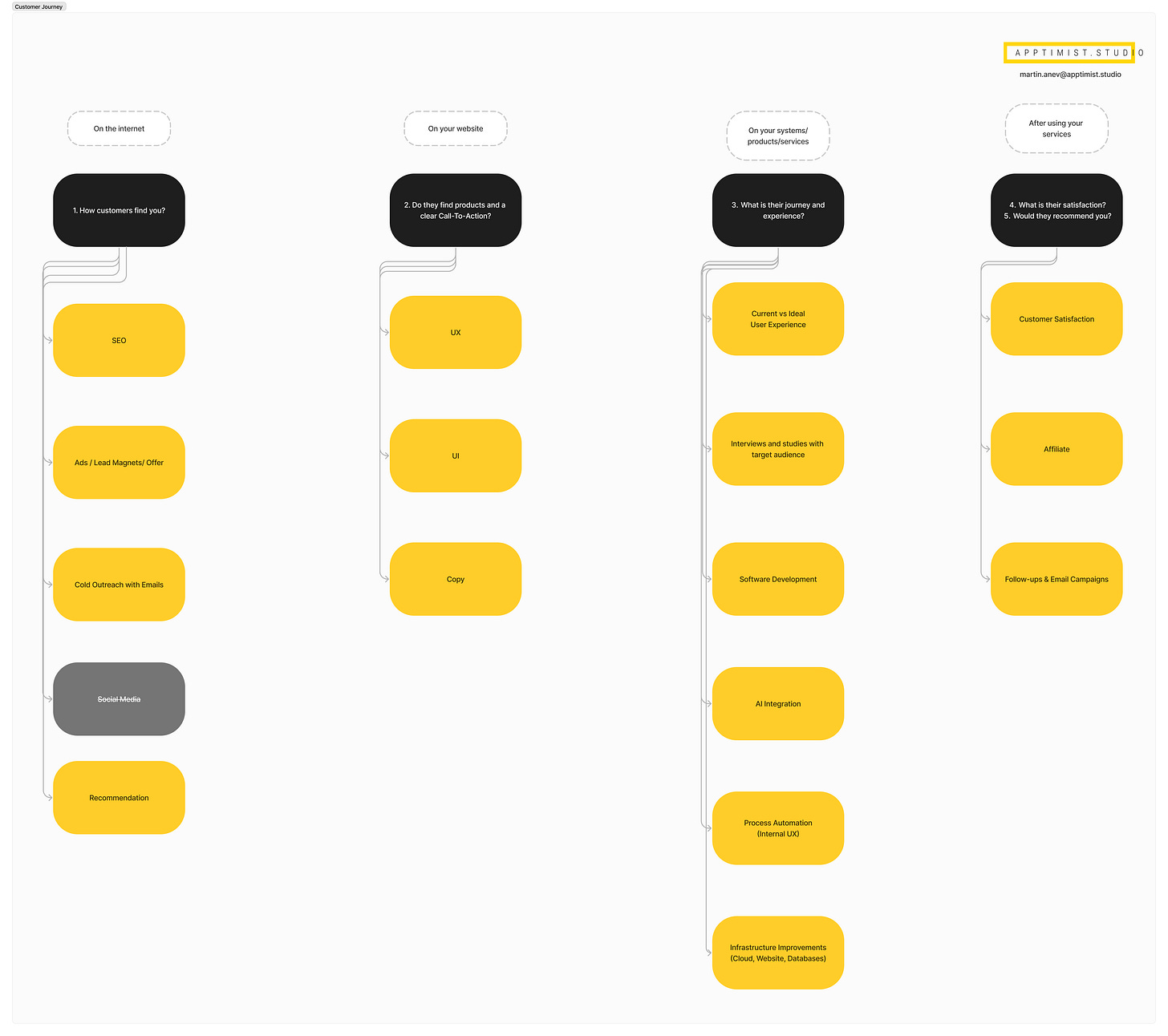How to Define Your Customer Journey: A Comprehensive Guide
In today's competitive market, understanding and optimizing your customer journey is crucial for the success of any startup or business. In this edition we break down what it is and steps to follow.
Building a thriving business is no small feat, especially when it comes to retaining customers and converting leads. For many companies, high customer acquisition costs can be a daunting challenge.
Without a clearly outlined customer journey, identifying the most effective channels and strategies for acquiring new customers becomes an arduous task. This trial-and-error approach often leads to higher costs as startups experiment with various methods without a clear strategy, draining valuable resources and impacting overall financial performance.
To tackle these issues, businesses need to clearly define their customer journeys. A well-mapped journey helps ensure that every customer interaction is purposeful and impactful. Let's first define what it is.
Customer Journey
The NN Group defines customer journey as the compilation of user goals and actions into a timeline skeleton. This skeleton is fleshed out with user thoughts and emotions in order to create a narrative.
At Apptimist Studio, we understand that every business is unique, which is why we offer customized strategies to help define and optimize your customer journey. By delving deep into your business model and customer base, we tailor our approach to fit your specific needs.
Take Thrive Circle, for example, a startup focused on habit building, mental health, and social networking. They faced challenges in effectively guiding their users through their platform. Our team worked closely with Thrive Circle to map out their customer journey, identifying key touchpoints and creating detailed user personas.
This personalized strategy allowed them to deliver relevant and timely interactions, significantly enhancing user engagement and retention. There are four key parts of the customer journey that we identify.
1. How Do Customers Find You?
The journey begins with visibility. Customers can discover your business through several channels, with SEO (Search Engine Optimization) being a primary method. SEO can be divided into two categories:
On-site SEO: This involves optimizing your website content to ensure it is relevant and visible to search engines. It includes keyword optimization, meta tags, and creating valuable content.
Off-site SEO: This encompasses the reputation you build online through backlinks from other websites, mentions in blog posts, podcasts, YouTube videos, newsletters, and more.
We offer a free SEO evaluation, you can go to ux.apptimist.studio to get your free report and one free fix today.
Besides effective SEO, customers can find you through various other means, such as ads and lead magnets, cold outreach, social media and content creation, recommendations, and word-of-mouth.
2. Is Your Product's Offering and Call-to-Action Clear?
Once customers find you, it is crucial that your website or app clearly communicates your offerings and guides them through the next steps. This involves:
Clear “Call-To-Action” and Next Steps
Effective landing pages
Visual aids and functional design
3. How Do Your Customers Interact With Your Product?
Mapping the customer journey involves understanding how customers interact with your business. We map out the current user experience and compare it with the ideal scenario to create a roadmap for improvements.
The design and development are based on this mapping, and the validation of hypotheses comes through user interviews to ensure that customers understand and use the services as intended.
4. Do Customers Recommend You?
Evaluating customer satisfaction, and encouraging recommendations, have three main components:
Customer Satisfaction Surveys: These should be integrated at the end of your service delivery to gather feedback and gauge customer satisfaction.
Affiliate Programs: Encourage your current customers to refer your business to others. Programs offering benefits for referrals can significantly boost your customer base.
Follow-ups and Email Campaigns: Regularly follow up with customers via email or other communication channels to maintain engagement. This not only reminds them of your services but can also prompt them to refer new customers.
💡 Discover the secrets behind effective customer journey mapping in this video where our CEO goes more in depth in how we help our clients enhance customer experiences.How to Define Your Customer Journey
Step 1: Identify Touchpoints
Identifying every possible interaction point between your business and your customers is crucial. These touchpoints can include website visits, social media interactions, customer service calls, and more. Mapping these out helps you understand where your customers engage with your business and what the potential next steps are.
Step 2: Use User Personas
User personas play a critical role in shaping a meaningful customer journey. These personas are detailed profiles that represent different segments of your audience, providing insights into their demographics, behavior patterns, goals, and pain points.
Align journey stages with personas
Identify pain points and motivations
Craft personalized interactions
For a deeper dive into creating and utilizing user personas effectively, we recommend reading our article, “What are User Personas and How to Create Them?”. You can learn more about what they are, valuable insights, and practical steps for developing robust personas that can transform your customer journey.
Step 3: Map the Customer Journey
With touchpoints and personas in hand, the next step is to map out the customer journey for each persona. This map should detail every interaction point, considering the customer’s feelings, motivations, and potential barriers at each stage.
Step 4: Optimize and Iterate
Finally, using data and customer feedback to continuously refine your customer journey is necessary. Collect insights from customer interactions, surveys, and analytics to identify areas for improvement and make adjustments accordingly.
Inefficiency and wasted resources are significant consequences of not having a clear customer journey. Startups may repeatedly invest in ineffective marketing and operational efforts, straining limited resources such as time, money, and manpower. This inflates operational costs without boosting revenue, misallocating funds that could otherwise support growth, marketing, or product development.
A well-defined customer journey ensures effective resource use and aligns business operations with customer expectations. It enables startups to deliver exceptional customer experiences at every interaction. By anticipating needs and addressing pain points proactively, businesses facilitate smoother transitions between journey stages, leading to increased customer satisfaction, stronger brand loyalty, and positive word-of-mouth, which is vital for a startup's reputation and market growth.
The Challenge!
With our template, you can evaluate and improve the clarity of your website's or app's user experience, especially if you're in the early stages of development. However, “the purchase journey” of your customer becoming aware of your product and completing the purchase is not the only scenario in which you can use this tool.
We challenge you to conduct this evolution about two other key moments:
Onboarding: The onboarding journey encompasses the initial interactions a customer has with your product or service after they make a purchase or sign up. This journey is crucial because it sets the tone for the customer's overall experience and determines their likelihood of continued engagement.
Support & Retention: The support and retention journey focuses on the ongoing relationship with customers after their initial purchase. Providing excellent support and maintaining engagement are key to customer retention and advocacy.
Work With AI
This section is only for our subscribers. If you would still want to get it anyway, feel free to send us an email at mba4startups@apptimist.studio and we will forward it to you.
PS: Our team at Apptimist Studio helps businesses with the planning, design, and execution of their plans. We help business owners and people with vision to execute their dreams and have beautiful, flawlessly working automated systems. Book a free discovery call with us here.
If you’d like to have access to more templates like this and other free resources, don’t forget to subscribe!



